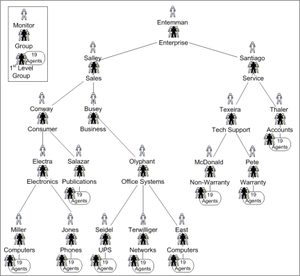Tailoring a Coaching Strategy
You can use the concepts explained in this section to tailor a coaching strategy. A coaching strategy can be modified at any time. In general, coaching strategies do the following:
- Specify values for rules and thresholds based on types of groups.
- Specify values for rules and thresholds based on types of agents.
- Provide a framework over time for continuous improvement.
Coaching Strategy Step 1
Consider our sample monitoring hierarchy in which the very first level under Enterprise groups the organization into Sales and Service. In a case like this, the coaching strategy configures sales-oriented values at the Sales node and service-oriented values at the Services node. For example, agents who are selling are most likely expected to talk longer than agents who are delivering customer service.
This Step 1 approach continues throughout the monitoring hierarchy, using inheritance when situations are similar, and using overrides when situations are different. For example, under the Sales group are Consumer and Business groups. These two groups are similar in some ways because the agents are selling, but they are also different because one group sells to consumers and the other group sells to businesses.
Agents in both groups are selling and would probably be expected to perform the same number of holds and transfers. So the two groups would be configured to inherit the hold and transfer thresholds from the Sales node. Wrap time for selling to consumers might take a shorter time than wrap time for businesses because the latter may include checking the balance in the business account. In this case, Consumer would have override values for Wrap Time different from the override values for Wrap Time in the Business group.
This Step 1 approach of specifying values according to similarities and differences of groups continues all the way down the tree to the agents.
Coaching Strategy Step 2
In any given group, some agents will be new and some will be experienced. Step 2 uses inheritance and override values at the agent level to coach differently according to agent type. For example, newer agents might be expected to talk a little longer than experienced agents, until the newer agents learn better call control, company policies, computer applications, and so on. Experienced agents know these things, so good coaching will challenge them with tighter override values to help them continue to improve.
Step 2 uses inheritance and overrides at the per-agent level, enabling coaching by agent type.
Sometimes Step 2 is required at the group level. For example, sometimes a “nest” is used to incubate new agents, while a “tiger team” is used to leverage the expertise of long-time, experienced agents. Step 2 would use inheritance and override at the group level in these cases, where groups are groups of agent types.
Coaching Strategy Step 3
Step 3 involves the improvement over time of Steps 1 and 2. Good coaching helps people get better over time by incremental improvements. In Step 3, coaches tighten or loosen values over time to challenge agents and help them continually improve their performance.

